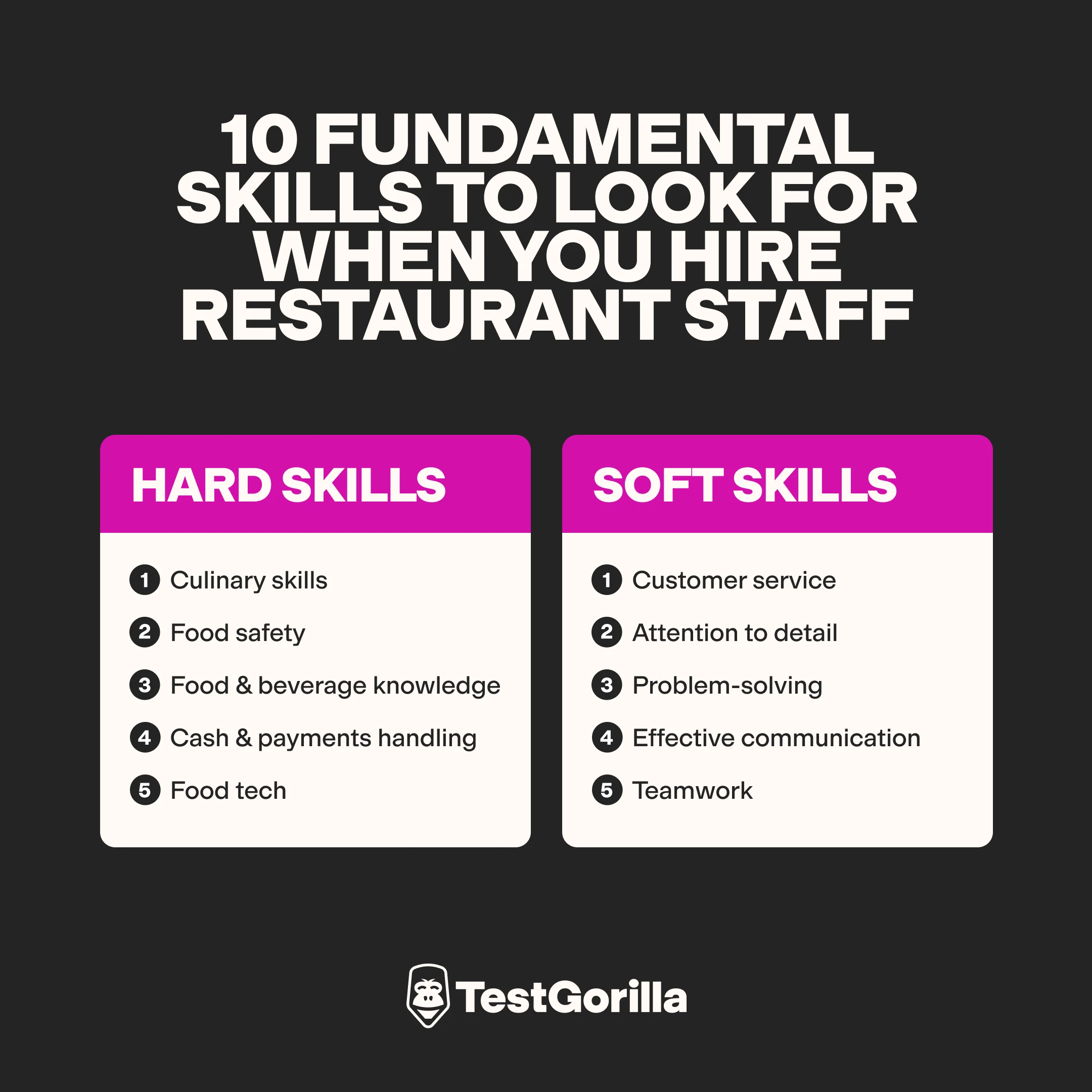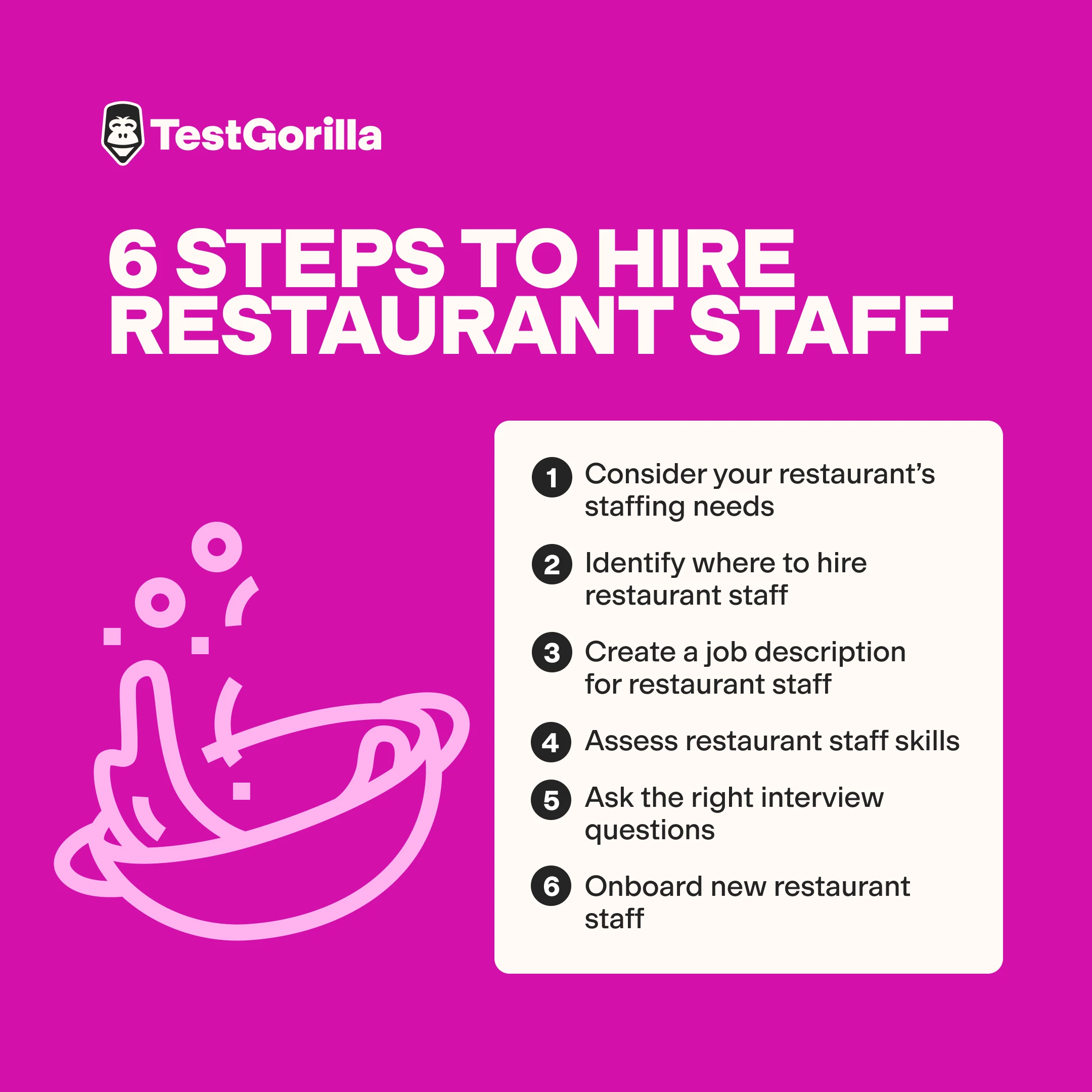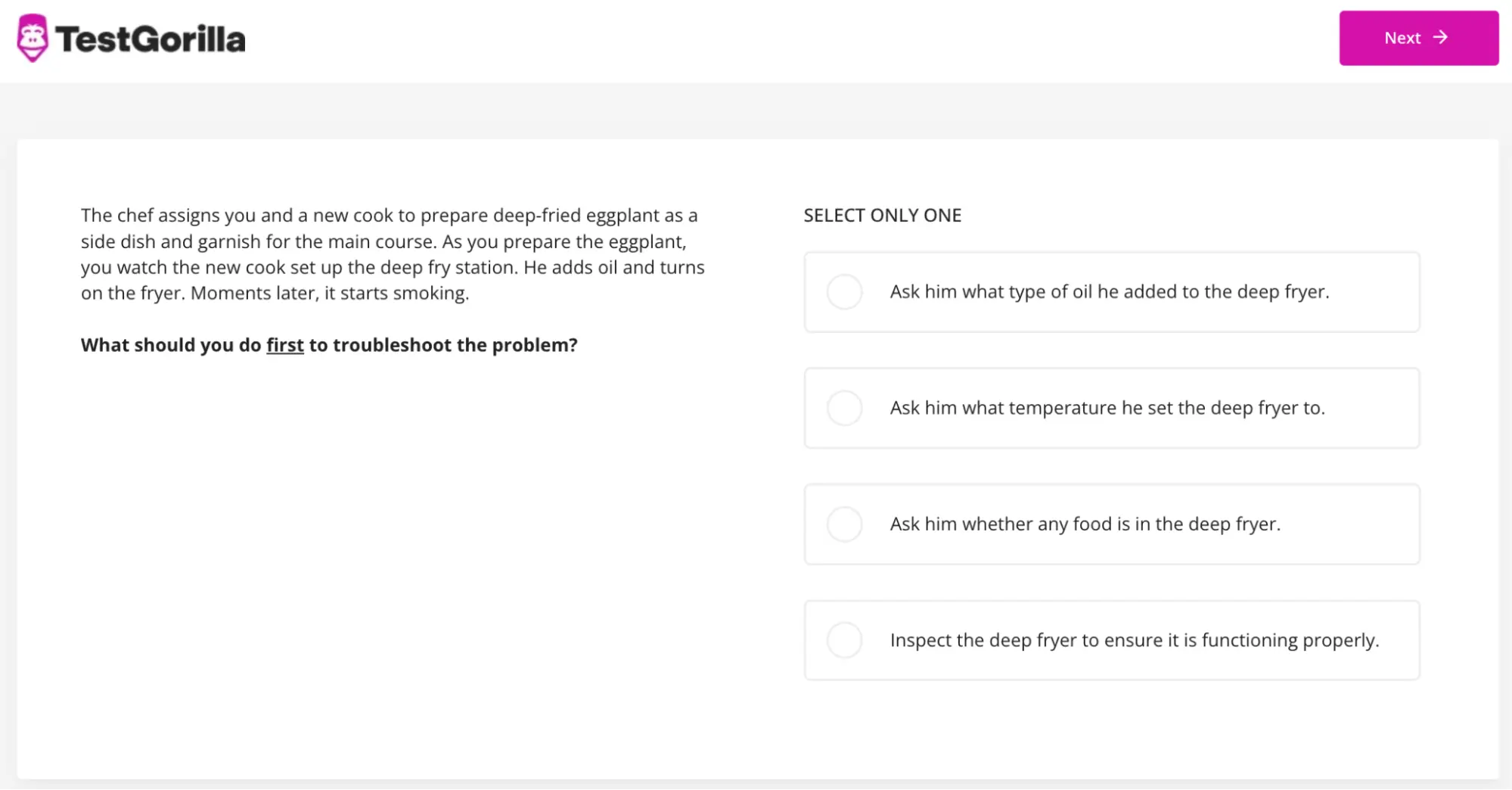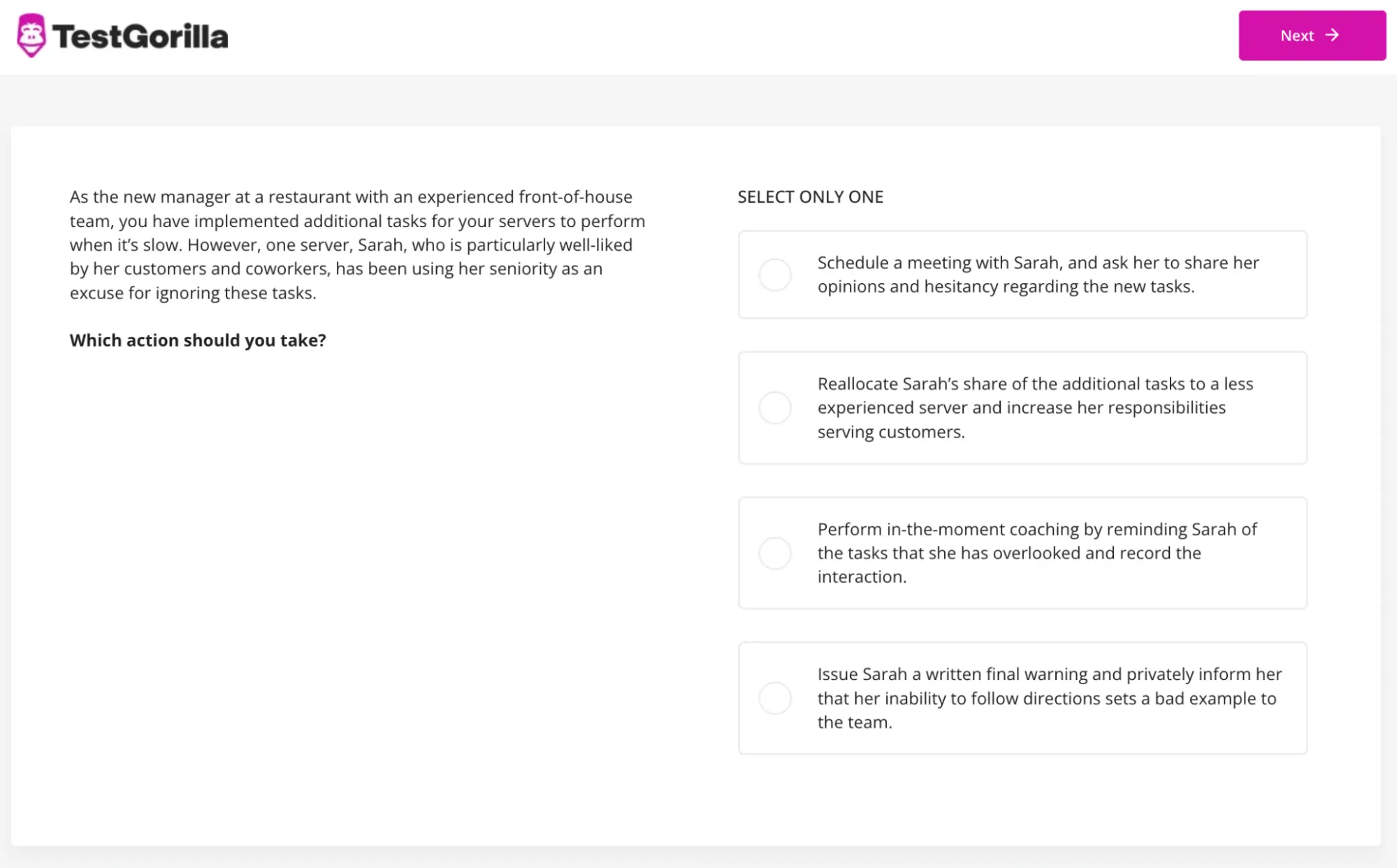How to hire restaurant staff: A 6-step guide
Hire the best restaurant staff with talent assessments
According to the National Restaurant Association, a shortage of restaurant staff is an issue for 78% of restaurant operators.
Considering that employee turnover is also at an all-time high and fewer young people enter the restaurant industry due to the demanding nature of the work and less competitive wages, the talent gap is widening.
In this guide, we discuss how to hire restaurant staff using talent assessments.
You can also find a detailed explanation of different restaurant roles, helpful information on average salaries in the hospitality industry, and a restaurant staff job description template for your job posting.
Table of contents
What are the main types of restaurant staff?
When hiring restaurant employees, there are three broad categories: front-of-house, back-of-house, and management.
Every role is different but equally important for the success of your restaurant.
Front of house (FOH)
This category includes jobs that require people to be in the restaurant’s public areas, such as waiting rooms, dining rooms, bars, and restrooms.
Front-of-house staff focus on interacting with customers but also stop by the kitchen to pick up dishes or give cooking directions.
FOH staff include:
Bartenders
Baristas
Hosts
Floor managers
Servers
Bussers
Cashiers
Barbacks
Back of house (BOH)
All restaurant team members working in the kitchen and away from the public eye are in the back-of-house category. They handle the kitchen, storage area, back office, prep areas, and walk-ins.
OH roles include:
Head chefs
Line cooks
Prep cooks
Sous chefs
Dishwashers
Expeditors
Management
Management handles the back office part of the restaurant. They analyze restaurant metrics, order inventory, strategize new promotions to keep the restaurant running and profitable and ensure the customers have a great dining experience.
Management positions in the restaurant industry include:
Assistant general managers
Bar managers
Shift managers
Accountants
10 fundamental skills to look for when you hire restaurant staff
When developing a strategy on how to hire staff for restaurants, it’s crucial to determine the most important skills for these jobs with high turnover.
Let’s explore the specific restaurant staff skills you should look for when hiring for job openings.
Hard skills | Soft skills |
Culinary skills | Customer service |
Food safety | Attention to detail |
Food and beverage knowledge | Problem-solving |
Cash and payments handling | Effective communication |
Food technology | Teamwork |
Restaurant staff hard skills
The hard skills you need to assess depend on the role you’re hiring for, but we’ve compiled a list of top industry-specific skills to consider in your hiring process:
Culinary skills: Chefs and line cooks must know various cooking techniques, understand flavor profiles, and create visually appealing and delicious dishes.
Food safety: Restaurant staff, especially managers and chefs, should understand the dangers of cross-contamination, undercooking, spills, and food allergies.
Food and beverage knowledge: Servers should accurately describe dishes to customers, including the ingredients used, cooking methods, and flavor palettes. Similarly, bartenders should have extensive knowledge of alcoholic and non-alcoholic drinks, including cocktails, wines, and whiskey.
Cash and payments handling: Many restaurant roles require the staff to handle cash, process credit and debit card payments, and operate a point-of-sale (POS) system. Your servers, bartenders, and managers must be proficient in these tasks to ensure error-free transactions and protect the financial integrity of the restaurant.
Food tech: People in FOH roles should be familiar with online ordering systems, POS technology, scheduling, and reservation software. Chefs and back-of-house staff should be familiar with inventory management software.
Restaurant staff soft skills
The soft skills of your staff ensure customers return to your establishment time and time again. Some of the top soft restaurant staff skills include:
Customer service: Your staff should be friendly, approachable, and attentive to customer needs to create a welcoming and enjoyable dining experience. That includes offering recommendations based on their orders, addressing any concerns or complaints right away, and having a willingness to go the extra mile to make the dining experience pleasurable.
Attention to detail: This soft skill helps servers remember orders from different tables, monitor drink refills, address any queries or concerns, clear tables promptly, and find opportunities to offer desserts or additional services when appropriate. The same goes for chefs and other BOH staff because they need to keep track of orders or details like how many portions of pasta are left.
Problem-solving: Your staff should be able to handle unexpected challenges, such as staff shortages, equipment failure, missing ingredients, customer complaints, and kitchen errors.
Effective communication: Excellent communication skills are crucial for restaurant staff to interact with customers, their colleagues, and other staff. Your staff should know how to pass orders, convey any customer allergy or ingredient requests, and resolve order issues.
Teamwork: Great teamwork reduces staff miscommunication, makes ordering more efficient, boosts team morale, and increases the rate and quality of the food coming out of the kitchen.
Unleash the power of effective skills testing with TestGorilla
Experience how our skills assessments can help you hire the best restaurant staff quickly and effectively.
How to hire restaurant staff: 6 steps
The turnover rate in the food and accommodation industry is 4.7%, more than double the national average rate of 2.2%. That means that restaurateurs and managers often have to scramble when hiring restaurant staff.
How to hire restaurant staff the right way: A summary
How to hire quality restaurant staff | Benefit |
1. Consider your restaurant’s staffing needs | Identify critical staffing gaps and align with operational goals for optimal service delivery. |
2. Identify where to hire restaurant staff | Expand your candidate pool by targeting the most effective recruitment channels for quality hires. |
3. Create a job description for restaurant staff | Attract suitable applicants by clearly defining roles, responsibilities, and qualifications. |
4. Assess restaurant staff skills | Ensure candidates meet specific role requirements through targeted skills assessments. |
5. Ask the right interview questions | Provide deeper insight into how potential employees handle real-world restaurant scenarios. |
6. Onboard new restaurant staff | Improve new hire retention and productivity through structured integration and training. |
1. Consider your restaurant’s needs
The best way to evaluate your restaurant’s needs is to analyze your busiest times and the workflow during those periods.
For example, if you notice a consistent bottleneck during peak dining hours with orders piling up, this can indicate a labor shortage and a need for more line cooks or kitchen assistants to streamline food preparation.
It can also mean your menu is too extensive, so your BOF staff can’t keep up with making everything from scratch.
Look for patterns of stress or delay. For example, are guests waiting too long to be seated, or is the kitchen struggling to keep up with orders? These observations can help you pinpoint which open positions are critical and need reinforcement.
In addition, you need to evaluate your future goals and any upcoming changes, such as menu adjustments or extended hours. These can require additional staff or diverse skill sets, which is why you need to be prepared.
2. Identify where to hire restaurant staff
Finding the best way to hire restaurant staff begins with knowing where to look. You can search for new employees on job platforms or use a more traditional approach like referrals to find the best restaurant job seekers.
Here’s where to hire restaurant staff:
Referrals: Restaurant workers rate teamwork and collaboration highly, so tapping into your existing network to find staff can be a great way of building a team with natural camaraderie. In addition, hiring a person via referral takes 29 days compared with a 39-day search on job boards.
Job sites: There are several job sites, like Indeed, where you can look for people actively searching for a role in the restaurant industry. In addition, you can try Culinary Agents or Poached Jobs because these platforms cater specifically to the hospitality industry.
Headhunting: Working with a headhunter for positions like managers and head chefs can help you find qualified candidates and expedite hiring. Ask for recommendations from your professional network and research firms with specialized experience in hospitality recruitment.
Social media: Social media is an excellent way of finding local industry talent because it helps you quickly reach local people. The best way to hire restaurant staff is to use LinkedIn, but you can also use Instagram to show your company culture and encourage potential employees to join your team.
3. Create a restaurant staff job description
There are many roles inside a restaurant business, each with unique responsibilities. That’s why creating an executive chef job description is different than trying to hire another line cook.
For example, if you’re writing a food and beverage manager job description, you want to focus on skills like leadership, financial acumen, and customer service to ensure efficient operations and exceptional dining experiences.
The restaurant staff job description template below can give you a starting point for hiring the most qualified restaurant staff:
Position: Server at [Restaurant’s name]
Responsibilities:
Greet and seat guests, providing exceptional customer service throughout their dining experience
Take accurate food and beverage orders and promptly relay them to the kitchen and bar staff
Provide menu recommendations and answer any questions or concerns from customers
Serve food and beverages promptly, ensuring proper presentation and adherence to quality standards
Process payments accurately, handle cash, and operate the POS system
Maintain a clean and organized workspace, including setting tables and refilling condiments as needed
Collaborate with colleagues and support teams to ensure efficient service
Address customer inquiries, concerns, and complaints professionally and promptly
Qualifications:
Strong knowledge of food and beverages
Excellent communication and customer service skills
Ability to handle cash and operate a POS system
Flexibility to work evenings, weekends, and holidays
Do note that the above listing is a server job description template. The responsibilities and qualifications change according to the role.
4. Assess restaurant staff skills
Once the applications start rolling in, you should have a clear strategy on how to hire quality restaurant staff.
The best way to hire restaurant staff is to use skills tests that measure relevant hard and soft skills.
At TestGorilla, we have developed specific skills for the hospitality industry. You can combine up to five tests in a single assessment to comprehensively evaluate your candidates.
Each test takes around ten minutes to complete and enables you to evaluate specific skills in depth.
Here are our recommendations for tests you can use to hire restaurant staff:
Customer Service test: Strong customer service skills are essential for front-facing restaurant staff. Hire candidates with a customer-centric approach to resolving problems and offering the best possible service. ommunication Skills test: All restaurant employees need to be excellent communicators, regardless of their specific role. This test helps you assess their communication skills and professional etiquette.
Cooking skills test: This cooking techniques test is ideal if you’re hiring for back-of-house roles because it helps you evaluate a candidate’s knowledge of common cooking techniques in a restaurant kitchen setup.
Hospitality skills test: Ask the candidates to take a hospitality test to measure their relevant skills, situational judgment, customer communication, and applied knowledge and determine whether they’re eligible for an entry- or mid-level role in your restaurant.
Restaurant Management test: This test can help you hire a strong and capable restaurant manager who works well under pressure and knows the ins and outs of the restaurant industry. It evaluates knowledge of food and safety standards, leadership, financial management, and the ability to improve customer experience.
If you want to find better talent using our skills assessments, book a live demo to learn more.
5. Ask the right interview questions
Conducting interviews provides additional insights into a candidate’s interpersonal skills, problem-solving abilities, and how they handle the fast-paced restaurant work environment.
Implementing a structured interview process enables you to consistently evaluate candidates for restaurant roles against the same set of criteria
Here are some questions you can ask during the interview:
How do you handle a situation where a customer is dissatisfied with their meal?
What strategies do you use to manage stress during busy seasons?
What’s the best way to manage inventory?
What do you think is the key to providing an exceptional dining experience for customers?
How do you stay updated with the latest food and beverage trends, and have you ever incorporated one into your work?
How would you adapt quickly to a restaurant change, such as a menu change or a staff shortage?
What role does technology play in improving restaurant operations, and can you give an example of how you use technology in your work?
Can you explain how you prioritize tasks during a busy shift to ensure the dining area remains clean and welcoming?
How do you manage a situation when the restaurant is fully booked, but a VIP guest arrives without a reservation?
6. Onboard new restaurant staff
A well-structured onboarding process increases employee retention by 82% and productivity by more than 70%.
This process helps new hires get familiar with how your restaurant operates and what their roles and responsibilities look like.
Here’s how you can do that:
Provide a welcome package with an employee handbook, uniform guidelines, and short info on restaurant history and values
Organize an orientation session to introduce new hires to the team, the restaurant’s layout, and its technology and systems
Develop a training program that covers all aspects of their role, from customer service protocols to menu knowledge and safety procedures
Ensure all staff members complete necessary compliance training, including food safety and health regulations
Set clear performance goals and expectations from the start, helping new hires understand what you expect from them
Schedule regular feedback sessions to discuss progress, give praise, and address concerns
How much does it cost to hire restaurant staff?
The salary of restaurant staff depends on their position, location, and even the restaurant concept. Many restaurants pay their staff by the hour, but most employees make the bulk of their income through tips.
According to Payscale, here are the annual salary ranges of some restaurant positions in the US:
Assistant restaurant manager: $34,000-$58,000
Bartender: $19,000-$60,000
Bar manager: $32,000-$65,000
Dishwasher: $20,000-$28,000
General manager: $42,000-$84,000
Head chef: $38,000-$77,000
Host: $14,000-$36,000
Kitchen manager: $35,000-$65,000
Sous chef: $37,000-$61,000
Server: $19,000-$64,000
There are several reasons for such big salary discrepancies among restaurant staff. For example, servers’ pay depends on key factors such as the restaurant’s location and type.
Restaurants in high-cost urban or high-traffic tourist areas offer better potential for higher tip earnings than casual or suburban restaurants. In addition, upscale dining venues typically have higher menu prices, which directly translate into larger tips.
Hire the best restaurant staff with TestGorilla
Hiring the right restaurant staff is the secret sauce every restaurant needs. Without it, you’re just serving a recipe for disaster with a side of unhappy customers. Get it right, and you get a feast of smiling faces coming back for seconds.
If you’re wondering how to hire restaurant staff the right way, the answer is clear – use skills assessments.
Take the product tour to learn how TestGorilla can help you evaluate applicants’ skills objectively and reduce hiring time.
Book a live demo to discover how to use our talent assessments for your specific hiring needs.
To experience better hiring today, start with a free forever plan!
How to hire staff for restaurants FAQs
If you still have questions on how to hire staff for restaurants, this section can help you get the right answers.
How do I hire someone in my restaurant?
Identify the necessary skills for the role
Determine how many workers you need
Write a job description for restaurant staff
Post jobs on industry-specific job boards and social media
Use talent assessments to screen applicants
Conduct structured interviews to assess skills
Verify references and conduct background checks
Extend a job offer and negotiate terms
Onboard the new hire
Why is it hard to hire restaurant workers?
As restaurant owners, it is hard to hire restaurant workers because the job market is increasingly competitive, and the best employees find jobs quickly. Economic fluctuations and seasonal demand also influence the best approach to how to hire restaurant staff. In addition, the demanding nature of restaurant work, including long hours and weekend shifts, can deter potential candidates.
How do I calculate how many staff I need for a restaurant?
Front of the house (Service/servers): Allocate one server per shift for every six tables, adjusting based on customer flow
Back of the house (Kitchen staff): Employ four kitchen staff per shift to efficiently serve up to 50 customers an hour
Supporting staff (Cashier, cleaners, accountant): Include one or two cleaners per shift to maintain cleanliness standards; consider additional staff, depending on operational demands
Related posts
Hire the best candidates with TestGorilla
Create pre-employment assessments in minutes to screen candidates, save time, and hire the best talent.
Latest posts
The best advice in pre-employment testing, in your inbox.
No spam. Unsubscribe at any time.

Hire the best. No bias. No stress.
Our screening tests identify the best candidates and make your hiring decisions faster, easier, and bias-free.
Free resources
This checklist covers key features you should look for when choosing a skills testing platform
This resource will help you develop an onboarding checklist for new hires.
How to assess your candidates' attention to detail.
Learn how to get human resources certified through HRCI or SHRM.
Learn how you can improve the level of talent at your company.
Learn how CapitalT reduced hiring bias with online skills assessments.
Learn how to make the resume process more efficient and more effective.
Improve your hiring strategy with these 7 critical recruitment metrics.
Learn how Sukhi decreased time spent reviewing resumes by 83%!
Hire more efficiently with these hacks that 99% of recruiters aren't using.
Make a business case for diversity and inclusion initiatives with this data.

























